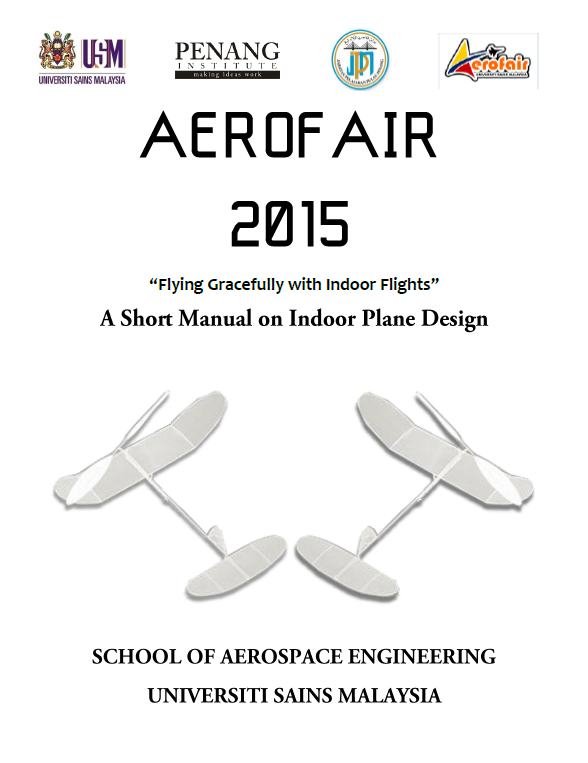For the AEROFAIR 2015 Workshop Session, we have prepared a short manual on how to build an indoor plane for the beginner’s level. The aim of this manual is to provide simple instructions and tips to guide students in building their indoor planes. This manual will be used to support our 3-hour Workshop Session. At the end of the workshop, our goal is to have the participants be able to produce a flyable indoor plane. The Flying Competition will be conducted afterward in the afternoon session.
Because of short duration of the workshop, we will focus on building just one design of the indoor plane, the beginner’s level Double Whammy design by Chuck Markos (you can check its flight video here and here).
This design is suitable for beginners and can fly up to 2 – 3 minutes. More details about it can be read in the National Free Flight Society website.
An improved version of the Double Whammy design is the Penny Plane design with a flight time of more than 5 minutes, but require more time to build, and therefore is not suitable for our short workshop. You can see its flight video here Normal indoor planes competing at international levels are designed to fly for more than 30 minutes, and the world record for a single flight is recorded at more than 1 hour.
In order to build a good indoor plane, several design aspects need to be carefully looked after. One important design aspect is on the aerodynamic aspect to ensure that the plane can produce lift and stable during flight. Another consideration is to make it able to fly in a circle so that it does not crash into the walls of the closed environment.
SHORT MANUAL
You can download the PDF version of the manual here: “A Short Manual on Indoor Plane Design“. The manual consists of the following sections:
- Introduction: Brief introduction on indoor planes.
- Beginner’s Indoor Plane Design: “Double Whammy”.
- Materials: Materials to be used in the workshop.
- Team Arrangement: How to arrange a team of 5 students in the workshop.
- Important Design Issues: Main design issues to make it fly upward and stable while flying in a circle.
- Schematic Diagrams of an Indoor Plane Design: Schematic CAD designs of an indoor plane from different angles.
For the teams competing in AEROFAIR 2015, please read through the manual before coming to the workshop so that we can make maximize the workshop time to actually build and fly the indoor planes. If possible, please print a copy of this manual to the AEROFAIR 2015 Workshop session.
PROGRAM BRIEFING
At the beginning of the workshop in the morning, we will give a 15-minute briefing on the process involved to build an indoor plane. In the briefing, we will inform participants on:
- Safety Issues: Especially on using cutting knives and 3-second glues.
- Team Arrangement: Each team will assign four separate roles to the members. The four roles are for members to build four different parts: fuselage, wing, tail, and propeller
- Building Parts: We will provide 4 main stations for each part to be built: fuselage, wing, tail, and propeller.
- Assembly: Each team will start to assemble the four finished parts to build a complete indoor plane.
- Flight Test: Once the plane is fully constructed, teams will test their planes.
- Improvement: During the flight test, teams need improve their planes to maximize their flight time.
TEAM ARRANGEMENT
For the AEROFAIR 2015 Indoor Flight competition, students will be grouped into teams of 5 students per team. Before the competition, each team will go through a 3-hour workshop to learn, build, and test their plane. Because of the relatively short duration of the workshop, we assign the following 4 roles for the students in each team to take:
- (Team Leader) Fuselage and Assembly: One student is needed to build the fuselage. This student will also be responsible to understand and supervise the entire process of assembling all parts to make the complete indoor plane. We recommend this student to be the leader of the group because he/she will oversee the overall assembly process.
- Wing: Two students are needed to build the wing. We recommend that one student is assigned to cut the balsa woods and another to glue the woods onto the wing skin (plastic wrapper). Building the wing is a very delicate process and we recommend students to be extra careful in all the steps involved, including building the two posts to attach the wing to the fuselage. The wing is the part that takes up the most time to build, between 1 to 1½ hour.
- Tail: One student is needed to build the tail. This student must also take the responsibility to understand the concept of stabilizing flight by using a tail to produce a downward force.
- Propeller: One student is needed to build two or three propellers for the single indoor plane that the team will build. The reason is that, in our experience, the propeller can easily break if the propeller or the propeller attachment system on the fuselage are not properly constructed. This student should also understand the technique to launch the plane.
For the rules and regulations of the Indoor Flight Competition, please visit this page for more details.

